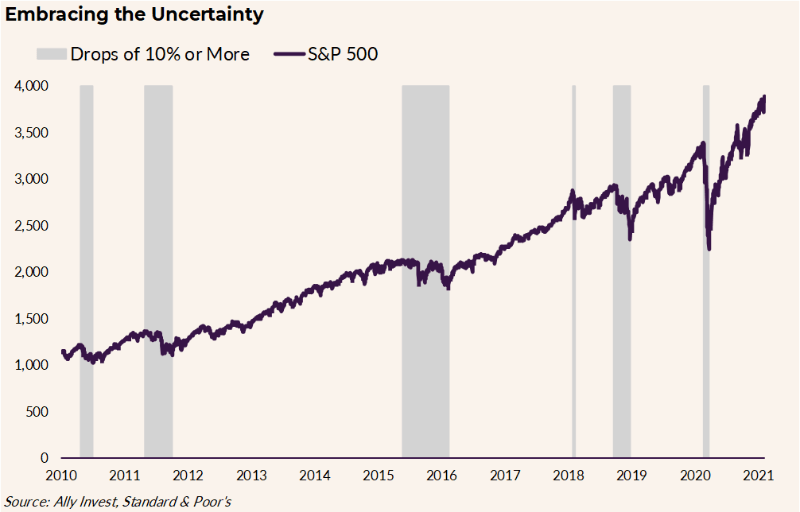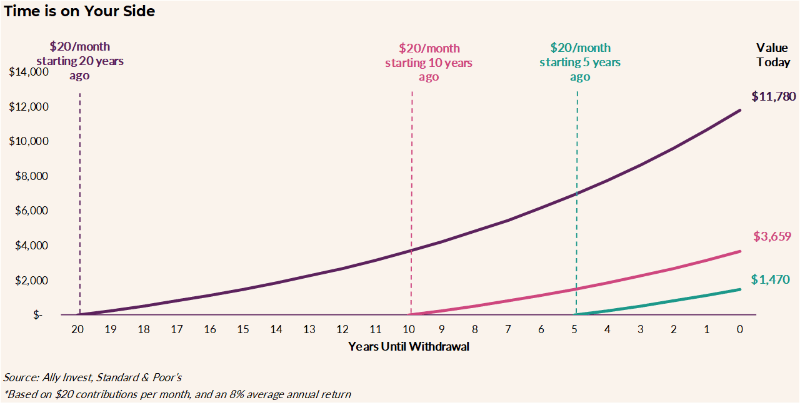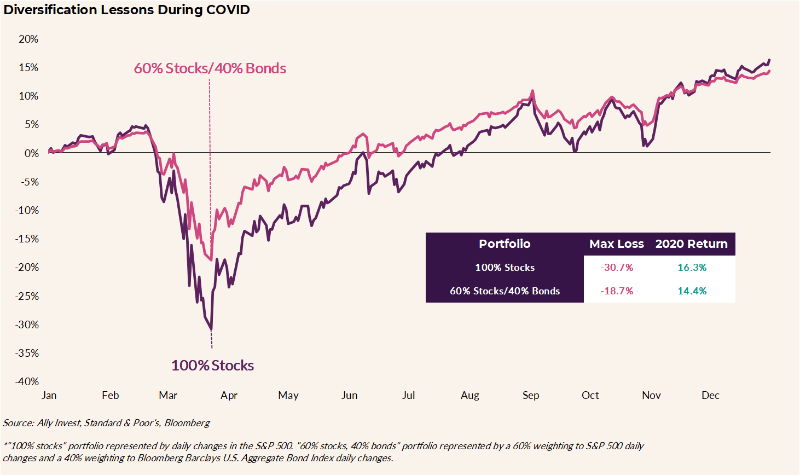Five basic principles of investing
- Feb. 17, 2021
- 4 min read
If you’re feeling a little lost on your investing journey right now, you’re not alone. Stocks are making record highs, yet we're still stuck in a global pandemic and feelings seem to overpower logic.
Investing in a normal environment can be a daunting experience, so it’s understandable if you’re a little overwhelmed now.
The noise can be deafening, but we’re here to help. Here are five basic principles of investing that can guide you through the ups and downs.

1. Embrace the uncertainty.
No one has a crystal ball, and things may feel unclear at times, but don’t let that keep you from focusing on your financial future.
You have to swallow a bit of uncertainty when investing. Sure, it’s tough to know for sure where the economy or stocks are heading in the next 12 months. The market’s moves are rarely predictable, especially when the market gets hit by a “black swan” event (one that nobody saw coming, like the COVID crisis). Even Wall Street’s best investors are frequently wrong about where the market is heading — even they don’t have a crystal ball!
Still, there can be value in investing, even if you don’t know what the future holds. Over the long term, stocks can provide investors with ample returns from a liquid, robust market. Since 1950, the S&P 500 has risen an average of 8% annually. During that time, investors have endured 11 economic recessions, 10 bear markets (drops of 20% or more) and 24 corrections (declines of 10% or more).
More recently, equities fully recovered from the Great Financial Crisis (and at the time, it felt like the world was ending). Investors who stayed patient during that turbulence reaped the benefits in the 10 years after that, during which the S&P 500 more than tripled in value.
2. Get started early.
As your time in the market increases, so do the benefits of compounding, or the exponential growth in your portfolio that can happen on top of any previous growth in your original investment. Compounding is the “snowball effect” that can happen when you invest, even small amounts, over a long period of time, and earn returns on your growth. It’s a powerful tool. Albert Einstein once reputedly even called compounding the “eighth wonder of the world.”
It may be difficult to motivate yourself to start now, and we get that. Doing anything for the first time requires some upfront work. But starting early is crucial in investing, even if you can’t put in much money at first.
Consider this: If you started putting $20 a month into a hypothetical, no-fee S&P 500 fund, you’d have about $1,500 at the end of five years (assuming the fund grew at an 8% average annual rate each year). Wait another five years, continue to invest $20 a month, and at that growth rate, you’ll have about $3,700. And if you’re super patient and watch your money grow, you’ll see about $11,800 at the end of 20 years (again, assuming that annual 8% growth rate).

Compounding can be tough to conceptualize, but don’t let that stop you from letting it work for you. If you have time on your side, you could have one of the best opportunities to start investing.
3. Diversify.
Market swings can be too much to stomach for some investors. That’s OK — we all have different risk tolerances. If you’re feeling that way, you may consider spreading your money out across a balance of aggressive and more conservative assets. That’s what Wall Street refers to when it preaches the benefits of diversification.
Throughout history, a portfolio with both stocks and bonds has proven to be more insulated from market stress than portfolios made up exclusively of stocks. Let’s go back to that hypothetical stock portfolio (based on the S&P 500) we talked about earlier. In the 2020 selloff, an investor holding that portfolio would have lost as much as 31% year-to-date. If that same investor allocated 60% of their money to that hypothetical S&P 500 portfolio and the remaining 40% to a diversified portfolio of bonds (represented by the Bloomberg Barclays U.S. Aggregate Bond Index), they would’ve only lost a maximum of 19% year-to-date.

Of course, you may give up some returns during the stock-market rebound, but that might be a fair trade if it helps you sleep soundly at night.
If you’re feeling a little uneasy, make sure you know all the tools in your toolbox. Defensive investments, such as gold and dividend-paying stocks, could provide reliable performance in the face of uncertainty. Gold may act as a buffer against an economic downturn, while high dividend payers tend to have more stable financial profiles.
4. Remain calm.
Above all, remain calm and remember your goals. Panic selling — or the act of selling when you don’t need to, just because the market is falling — is one of the biggest mistakes you can make. Historically, the S&P 500’s worst days and best days have occurred in clusters. Last year was a great example. If you sold stocks on March 16 (the day the S&P 500 fell 12%, its worst drop since 1987), you would have missed some — or all — of the 40% rebound we saw through June 8.

The opposite scenario — trying to sell at the right moment — could also be a huge risk.
The moral of the story? Avoid emotional investing by making decisions according to your plan. Besides, as we mentioned earlier, time in the market beats timing the market. If you have time on your side, it may be better not to sweat the daily ups and downs.
5. Think big picture.
Above all, it’s important to think about the big picture. It may be tempting to jump into the hot stocks when they’re going up, but are they a suitable investment for your own goals? Often, the best strategy for a long-term investor is to keep it simple.
You might’ve heard about all the tech darlings that crushed the market last year. But what you didn’t hear much about were the slew of stocks that ended up doing poorly. Last year, about 63% of all stocks in the Russell 3000 returned less than the index and about 20% of them fell 20% or more during the year.
Single stocks have a place in portfolios: They’re a great way to support an idea you’re excited about, and some of them may turn out to be market success stories. Look at Apple: If you invested $100 in its 1982 public offering, you’d have over $100,000 today! But they’re typically more volatile as well, and you could lose money quickly if the company stumbles. In other words, stock-picking can be hard.
If you want a piece of the stock market instead of just one stock, there are plenty of exchange-traded and mutual funds that could give you exposure to sectors and indexes (like the S&P 500). Why pick one when you can own them all?
We're here for you.
Good news: If you’re reading this, you’ve already taken the first step in your investing journey. Taking the plunge and making that first investment may seem like a daunting task, but we’re here for you.
Remember to know your why and set your money goals before you start and keep these five principles in mind as you navigate the market.
Lindsey Bell is an award-winning investment professional with a passion for personal finance and more than 17 years of Wall Street experience. Bell’s unique ability to connect the dots between data and real life and craft bite-sized money ideas that people can use and apply stems from her deep background as an analyst, researcher and portfolio manager at organizations including J.P. Morgan and Deutsche Bank. She is known for demonstrating why and how an understanding of all things money improves a person’s finances and overall well-being. An ongoing CNBC contributor, Bell empowers consumers and investors across all walks of life and frequently shares her insights with the Wall Street Journal, Barron’s, Kiplinger’s, Forbes and Business Insider. She also serves on the board of Better Investing, a non-profit focused on investment education.
Read next
Money solutions and strategies sent straight to your inbox.
Tips and tools to help you build your best financial future.


